Several factors, including genetics, age, and gender, can cause hip conditions in young adults and footballers. Many people believe that hip problems only affect older generations, but new research has found that the condition among youngsters is becoming more common. Here are the Primary causes of the hip condition in young adults and footballers;
1. Hip impingement
The hip joint ball pressing on the head of the femur causes hip impingement. This causes pain, leading to joint instability, degeneration, and arthritis.
Hip impingement is most common in young adults who participate in sports requiring them to maintain a high degree of balance, such as soccer or basketball. It can also occur due to repetitive use of a particular movement pattern, such as running without sufficient recovery time between repetitions.
Hip impingement can also be caused by;
Perthes Disease – A condition in which the head of the femur wears down and becomes sharper than normal, causing pain and impingement in the hip joint.
2. Osteoarthritis
Osteoarthritis is the most common hip condition in young adults, affecting about half of all people over 20. The cause of this condition is not fully understood, but it may be partly genetic. Osteoarthritis is characterized by a degeneration of the cartilage in the joint, which can lead to pain and disability. The symptoms of osteoarthritis include:
- Pain in one or both hips
- Numbness or tingling sensations in the hip area
- Pins and needles feeling
- Difficulty walking or climbing stairs
3. Foot injuries
Foot injuries can lead to conditions like plantar fasciitis pain in the bottom of the foot. Plantar fasciitis results from inflammation of a bone on one side of the bottom of the foot called the plantar fascia, which runs along your arch, connecting each toe to its corresponding foot bone metatarsals. In addition to pain, this condition may also cause heaviness or numbness in that area of your foot, stiffness, limited motion at the ankle, swelling, skin redness around that area, and decreased range of motion or muscle strength in that region.
4. Labral Tears
Injuries to the labrum are common among footballers, particularly those who use their hips excessively during play. A torn labrum is a condition where the rim of the socket, the ball, and the socket have been torn away. This can occur because of a direct blow or repetitive movements with overuse. The most common cause of this condition is an excessive force applied to the hip during play, often through kicking techniques such as kicking high or kicking low which involve using a lot of force towards the front of the body when kicking. erratichour
5. Posterior Impingement Syndrome
The posterior aspect of your hip is called the ‘gluteal region and this area tends to get tight as you age due to constant sitting down throughout your working day. As a result, it becomes difficult for you to return to normal activity once you have rested. So muscle tension builds up in this area which can lead to pain if not addressed properly by physiotherapy treatment or even surgery if necessary.
6. Hip Flexor Strain
The hip flexors are a group of muscles that connects the pelvis to the thigh. They are the large muscles at the front of your thighs, and they help you bend your knees and trunk forward. The hip flexors can become strained if overworked, misused, or injured.
This condition can be treated with pain-reducing medication and physical therapy exercises. However, if it persists or gets worse, surgery may be necessary.
The most common reason for a hip flexor strain is poor core stability. To strengthen your core, do these exercises;
-
Leg raises
Lie on your back with both legs straight up in the air and feet pointed toward the ceiling. Lift one leg until it’s parallel to the floor and holds for 10–15 seconds before lowering. Repeat three times on each side.
-
Planks
Start in a pushup position with your forearms on the floor, hands directly under your shoulders, and elbows bent at 90 degrees. Keep your abs engaged and straighten your legs so they’re at least shoulder-width apart. Hold this position for up to 30 seconds while keeping your hips lifted off the floor and glutes tight.
7. Avascular Necrosis
Avascular necrosis is when the bone becomes soft, and the blood supply to the bone tissue is interrupted. The result is that the bone dies and falls out of place.
In footballers, avascular necrosis can be caused by repeated impact on the knee with sudden deceleration. This can damage the articular cartilage at the surface of the knee joint, which then loses its resilience and becomes vulnerable to injury.
The risk of damage to cartilage increases with age, so it is more common in older people who have played football for many years. However, it can occur in younger players who have been playing for many years, particularly if they play on artificial grass surfaces not fitted with protective padding.
Finally, the above is a brief overview of the primary causes of the hip condition leading young adults to undergo hip replacement surgery. Football players, however, are most commonly affected by this condition.

